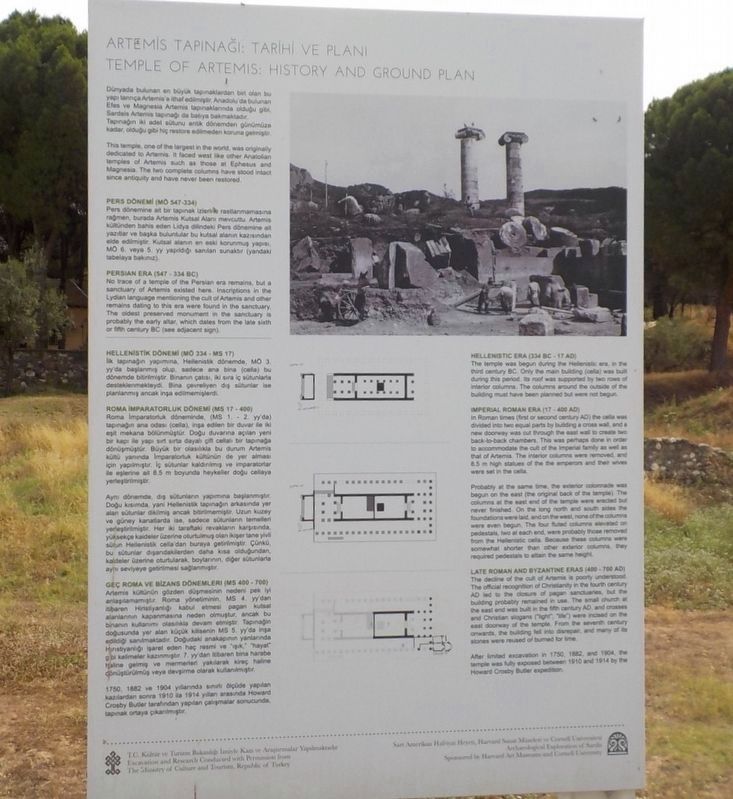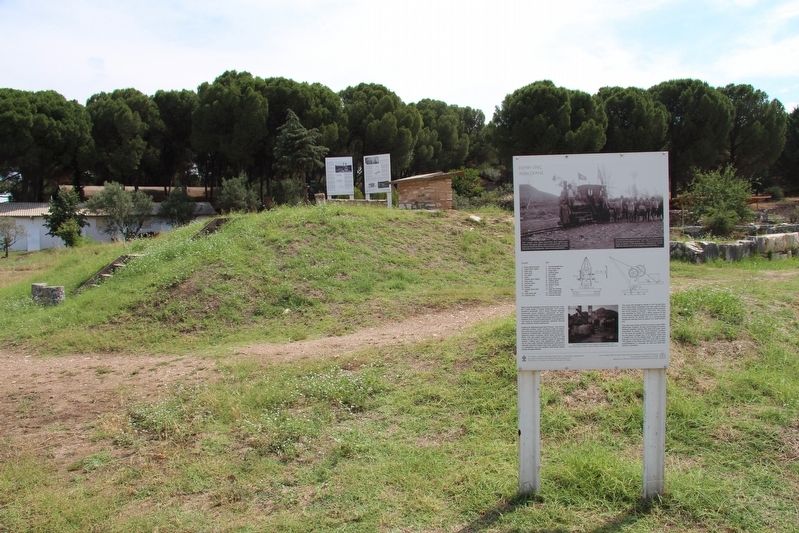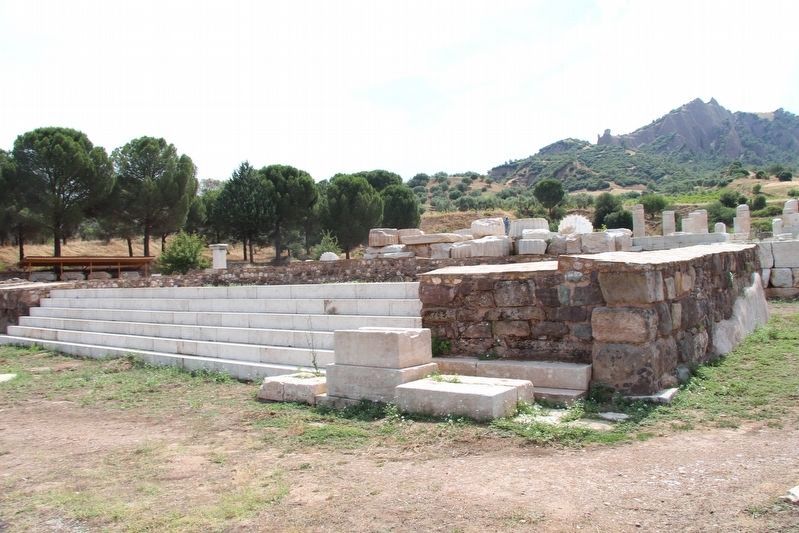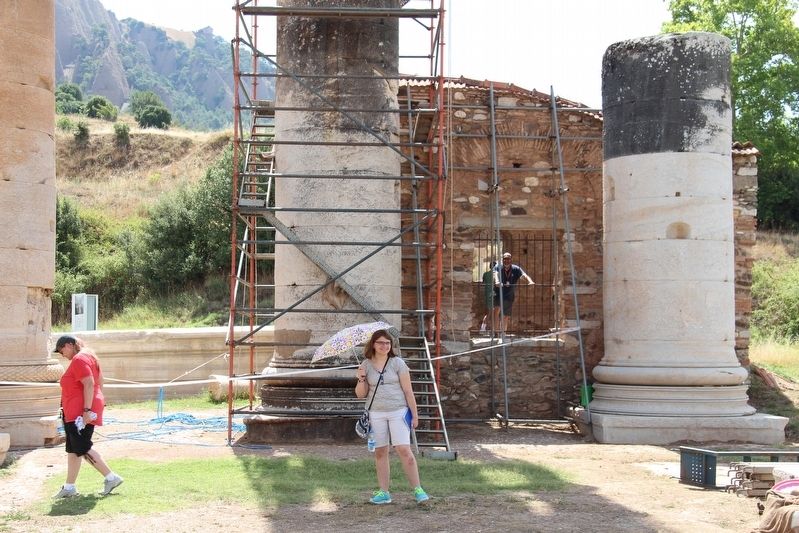Near Sart in Salihli, Manisa, Turkey — West Asia or Southeast Europe
Temple of Artemis: History and Ground Plan
English Text;
The temple, one of the largest in the world, was originally dedicated to Artemis. It faced west like other Anatolian temples of Artemis such as those at Ephesus and Magnesia. The two complete columns have stood intact since antiquity and have never been restored.
Persian Era (547-334 BC)
No trace of a temple of the Persian era remains, but a sanctuary of Artemis existed here. Inscriptions in the Lydian language mentioning the cult of Artemis and other remains dating to this era were found in the sanctuary. The oldest preserved monument in the sanctuary is probably the early altar, which dates from the late sixth or fifth century BC (see adjacent sign).
Hellenistic Era (334 BC-17 AD)
The temple was begun during the Hellenistic era, in the third century BC. Only the main building (cella) was built during this period. Its roof was supported by two rows of interior columns. The columns around the outside of the building must have been planned but were not begun.
Imperial Roman Era (17 - 400 AD)
In Roman times (first or second century AD) the cella was divided into two equal parts by building a cross wall, and a new doorway was cut through the east wall to create two back-to-back chambers. This was perhaps done in order to accommodate the cult of the imperial family as well as that of Artemis. The interior columns were removed, and 8.5 meter high statues of the emperors and their wives were set in the cella.
Probably at the same time, the exterior colonnade was begun on the east (the original back of the temple). The columns at the east end of the temple were erected but never finished. On the long north and south sides the foundations were laid, and on the west, none of the columns were even begun. The four fluted columns elevated on pedestals, two at each end, were probably those removed from the Hellenistic cella. Because these columns were somewhat shorter than other exterior columns, they required pedestals to attain the same height.
Late Roman and Byzantine Eras (400-700 AD)
The decline of the cult of Artemis is poorly understood. The official recognition of Christianity in the fourth century AD led to the closure of pagan sanctuaries, but the building probably remained in use. The small church at the east end was built in the fifth century AD, and crosses and Christian slogans ("light," "life") were incised on the east doorway of the temple. From the seventh century onwards, the building fell into disrepair, and many of its stones were reused or burned for lime.
After limited excavation in 1750, 1882, and 1904, the temple was fully exposed between 1910 and 1914
by the Howard Crosby Butler expedition.
Erected by The Ministry of Culture and Tourism, Republic of Turkey, and the Harvard Art Museums and Cornell University.
Topics. This historical marker is listed in these topic lists: Churches & Religion • Parks & Recreational Areas.
Location. 38° 28.788′ N, 28° 1.825′ E. Marker is near Sart, Manisa, in Salihli. Marker can be reached from Kenan Evren Cd. just east of Sart Yolu, on the right when traveling east. This marker is on the grounds of the Sardis Archaeological Park, near the ruins of the Temple of Artemis, on a small mound, right next to another marker, along a trail that leads to the Temple site. Touch for map. Marker is in this post office area: Sart, Manisa 45370, Turkey. Touch for directions.
Other nearby markers. At least 8 other markers are within walking distance of this marker. The Altar of Artemis (here, next to this marker); Iron Crane (a few steps from this marker); Roman Avenue (approx. 1.2 kilometers away); Boya Dükkán / Paint Shop (approx. 1.2 kilometers away); Tuvaletler / Latrines (approx. 1.2 kilometers away); Lokantalar / Restaurants (approx. 1.2 kilometers away); Mesken / Residence (approx. 1.2 kilometers away); (Yakub'un) Boya Dükkáni / (Jacob's) Paint Shop (approx. 1.2 kilometers away). Touch for a list and map of all markers in Sart.
Credits. This page was last revised on June 30, 2018. It was originally submitted on June 30, 2018, by Dale K. Benington of Toledo, Ohio. This page has been viewed 183 times since then and 27 times this year. Photos: 1, 2, 3, 4, 5. submitted on June 30, 2018, by Dale K. Benington of Toledo, Ohio.




